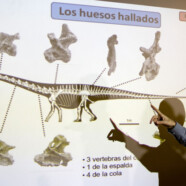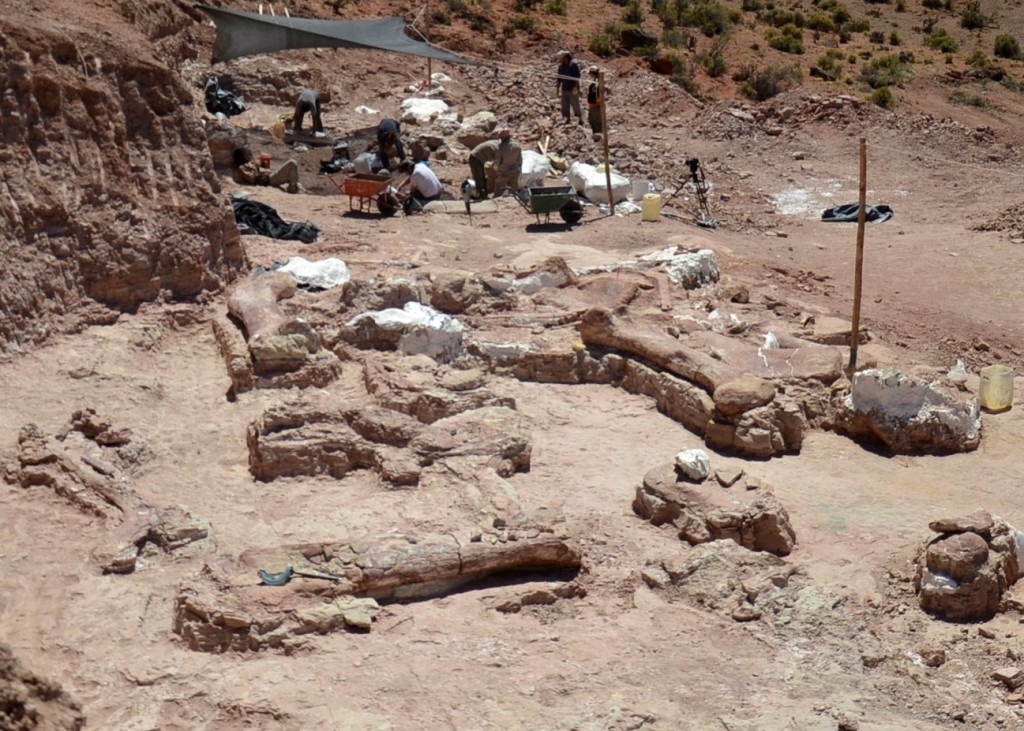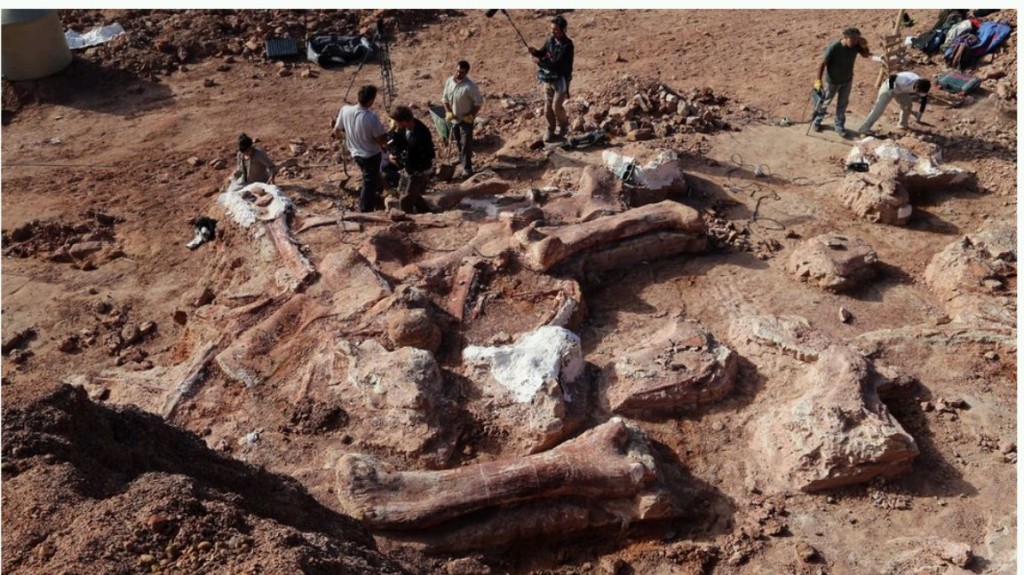World’s Largest Dinosur Discovered
A team of scientists led by researchers from MEF found remains of a new species of dinosaur 95 million years ago; possibly the largest that ever lived on our planet. This unique discovery not only gives the dimensions and quantity of fossils, but also for its unusual state of preservation.
No less than seven huge herbivorous dinosaurs, perhaps the largest creatures that walked the earth, were found at one site in the province of Chubut (Argentina). The finding surprised scientists, until now, only knew the anatomy of these giants based on rather few species remains poor.
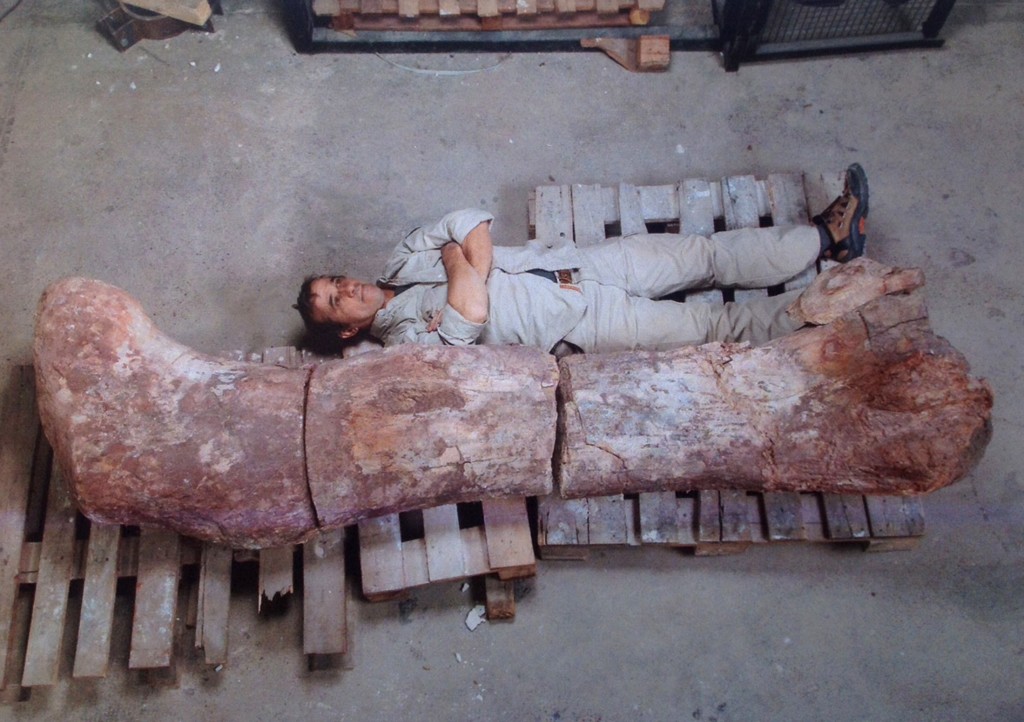
A technician lies next to the femur of a dinosaur at the Egidio Feruglio Museum in Argentina’s Patagonian city of Trelew, in this photo provided by Telam on May 16, 2014. Paleontologists have unearthed in Argentina what they say is the largest set of remains of a dinosaur ever found to date. According to paleontologists from the renowned Egidio Feruglio Museum, Jose Luis Carballido and Ruben Cuneo, the fossils are that of a sauropod and preliminary tests dates the fossils at some 90 million years old. (Credit: REUTERS/Telam/Museo Egidio Feruglio)
These animals lived in the late Mesozoic era when dinosaurs dominated terrestrial ecosystems. One group in particular developed truly giant forms: sauropod dinosaurs, characterized by quadrupedal gait with very long neck and tail and a small skull. According to investigators, the remains belong to a particular group of sauropod dinosaur, called titanosaurs, including extremely large animals like Puertasaurus, found in Santa Cruz, and the Argentinosaurus Neuquen.
Initial analyzes suggest that the newly discovered species have reached 40 meters in length and 80 tons in weight. “It’s like two semi trucks, one after another, and the equivalent of more than 14 African elephants together weight,” says José Luis Carballido, dinosaurs MEF specialist and in charge of the study of these specimens.
Such dimensions put the focus on the extent to which these animals may have grown. “It’s a real paleontological treasure,” he adds. “There were many and they were practically remains intact, which does not happen often. In fact, the remains of giant titanosaurs known to be slow and fragmented. ”
Dinosaur Graveyard
Located in the center of the province of Chubut, the new site produced more than 200 fossils. There, researchers found neck and much of the back, most of the vertebrae of the tail and fore and hind legs, among other bones. Moreover, among the remains had 60 teeth large carnivorous dinosaurs.
The presence of seven adult specimens together, and the type of reconstructed environment, indicate that the animals died in the same place of discovery. Probably during drought periods sauropods were attending small pools of water to drink, and maybe some died of dehydration product or get stuck in the mud. The accumulation of these animals might be a feast for scavengers like Tyrannotitan large. “Probably frequented the place to scavenge the remains of herbivores. But the feast was a high price to bite the hard skin and flesh of these giants often had to break their teeth, although later regenerated “says Carballido.
The site also plant remains were found, including large logs and imprints of leaves that reveal a very different current Patagonian landscape. Samples collected indicate that 95 million years ago there were huge trees with rich flowering plants (angiosperms) and in the process of diversification lower strata.
Opening Pathways
The team of scientists and technicians had hard work to extract, protect and transfer the fossil to MEF in Trelew. “There was no way to the place, so we had to do, and for this we have the invaluable support of the Provincial Department of Roads,” says the specialist.
Much of the work of extracting fossil is handmade as jackhammers, shovels, picks and brushes are used to remove part of the sediments. But the removal of large fossil is more complex and requires the use of backhoes and bulldozers move to allow large volumes of rock. In the process, both provincial Highways, National Road Administration and the National Atomic Energy Commission actively assisted by the provision of tools and equipment.
The scientific study is conducted by specialists in different areas of paleontology and geology. For example, to find clues about the growth of the new species researchers are conducting histological studies (microstructure of the bones), muscle, taphonomic (postmortem history of animals) and biogeographical, among others.
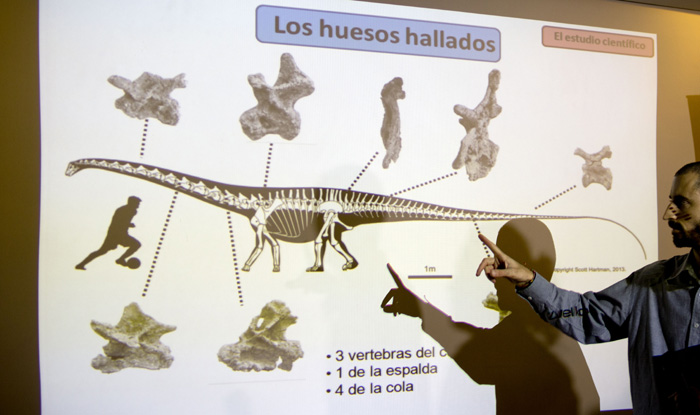
Led by Drs. Carballido and Diego Pol (MEF), the team is composed of Drs. Leonardo Salgado and Ignacio Cerda (National University of General Roca), Alejandro Otero (National University of La Plata), Alberto Garrido (Olsacher Undermine Museum), Juan Ignacio Canale (Paleontological Museum Chocón), Jose Ignacio Canudo (University of Zaragoza) Martin Umazano (National University of La Pampa) and Marcelo Krause (MEF). The Department of the MEF, led by Pablo Puerta, assisted in the work of extraction, transportation and packaging of fossils. Scientists also had the support of the Ministry of Culture of Chubut, and a large team of staff and volunteers for fieldwork.
An extraordinary site
The site is located in the center of the province of Chubut, about 260 km from the city of Trelew and near the town of El Sombrero. The discovery was reported in 2011 to MEF for rural farmworker family property Mayo who provided hospitality both installing the camp and during the working days.
“Still working on this extraordinary site,” says Carballido. “We estimate that one fifth of the completed excavation process, so there is still much work to do and probably much to discover.”
Source: MEF (Paleontological Museum Egidio Feruglio)
======================================
video source: CBS Evening News

